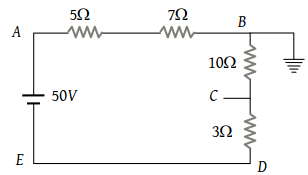If a resistance R2 is connected in parallel with the resistance R in the circuit shown, then possible value of current through R and the possible value of R2 will be

(1)
(2)
(3)
(4)

A battery of emf \(10\) V is connected to resistance as shown in the figure below. The potential difference \(V_{A} - V_{B}\)
between the points \(A\) and \(B\) is:

1. \(-2\) V
2. \(2\) V
3. \(5\) V
4. \(\frac{20}{11}~\text{V}\)
A student has 10 resistors of resistance ‘r’. The minimum resistance made by him from given resistors is :
(1) 10 r
(2)
(3)
(4)
Two wires of same metal have the same length but their cross-sections are in the ratio 3 : 1. They are joined in series. The resistance of the thicker wire is 10 Ω. The total resistance of the combination will be
(1) 40 Ω
(2)
(3)
(4) 100 Ω
The equivalent resistance of the following infinite network of resistances is
(1) Less than 4 Ω
(2) 4 Ω
(3) More than 4 Ω but less than 12 Ω
(4) 12 Ω
In the figure given below, the current passing through 6 Ω resistor is
(1) 0.40 ampere
(2) 0.48 ampere
(3) 0.72 ampere
(4) 0.80 ampere
The equivalent resistance between points A and B of an infinite network of resistances each of 1 Ω connected as shown, is
(1) Infinite
(2) 2 Ω
(3)
(4) Zero
In the circuit shown, the point ‘B’ is earthed. The potential at the point ‘A’ is :
(1) 14 V
(2) 24 V
(3) 26 V
(4) 50 V
In the circuit shown below, the cell has an e.m.f. of 10 V and internal resistance of 1 ohm. The other resistances are shown in the figure. The potential difference is :
(1) 6 V
(2) 4 V
(3) 2 V
(4) –2 V
A wire of resistance R is cut into ‘n’ equal parts. These parts are then connected in parallel. The equivalent resistance of the combination will be :
(1) nR
(2)
(3)
(4)







